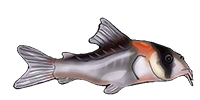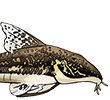One organism responsible for nitrification instead of two
-
NCE12940
- Posts: 211
- Joined: 22 May 2014, 04:31
- I've donated: $20.00!
- My cats species list: 7 (i:7, k:0)
- My aquaria list: 6 (i:5)
- Location 1: Midland
- Location 2: Texas
- TwoTankAmin
- Posts: 1506
- Joined: 24 Apr 2008, 23:26
- I've donated: $4438.00!
- My cats species list: 6 (i:0, k:0)
- My BLogs: 2 (i:0, p:30)
- Location 1: USA
- Location 2: Mt. Kisco, NY
- Interests: Fish and Poker
Re: One organism responsible for nitrification instead of two
I wonder how prevalent this newly discovered bacteria might be in aquariums. People are adjusting to the idea that the ammonia oxidation in tanks may be assisted or entirely performed by Archaea. It is clear that AOA are likely present to some degree in established tanks even if it is bacteria which does the job initially. Now we see this new evidence for a bacteria which does both the ammonia and nitrite oxidation.
What fascinates me about all of this is that we now have substantial studies that detect the AOB and NOB and AOA in tanks and other aquatic environments. Add the new discovery to this and we have possibly detected a third distinct organism doing some or all of the nitrification in tanks. So we now see four distinct organisms at work in tanks- AOB, NOB, AOA and this new type of Nitrospira. Clearly, those studies which have identified each of these organisms being present in tanks have not misidentified what is present. At worst, they missed something else that was there.
So where does this leave us as hobbyists? Can we no longer state that it is this one or that one which is at work in tanks but rather there is a menu of organisms which are capable of handling nitrification and that different tanks from different regions may or may not contain any one or some combination of such microorganisms?
Prior to about 1996 it was believed that the same bacteria that worked in waste water treatment were the ones in tanks. Then it was determined it was actually completely different bacteria doing the work. In about 2005 the ammonia oxidizing archaea were discovered in sw and a few years later in fw tanks. And here we are not a decade from that to where a new autotrophic bacteria which can process ammonia directly to nitrate has been discovered (assuming the discoveyr is borne out by future research).
It seems that the more we learn the less we know about what may actually be going on in tanks. It may turn out that there are a number of microorganisms which might be responsible for nitrification in tanks but that no single one or grouping of multiple organisms is dominant in all tanks. Could it be that there are specific factors involved which determine what combination of organisms may start out and end up in tanks.
What fascinates me about all of this is that we now have substantial studies that detect the AOB and NOB and AOA in tanks and other aquatic environments. Add the new discovery to this and we have possibly detected a third distinct organism doing some or all of the nitrification in tanks. So we now see four distinct organisms at work in tanks- AOB, NOB, AOA and this new type of Nitrospira. Clearly, those studies which have identified each of these organisms being present in tanks have not misidentified what is present. At worst, they missed something else that was there.
So where does this leave us as hobbyists? Can we no longer state that it is this one or that one which is at work in tanks but rather there is a menu of organisms which are capable of handling nitrification and that different tanks from different regions may or may not contain any one or some combination of such microorganisms?
Prior to about 1996 it was believed that the same bacteria that worked in waste water treatment were the ones in tanks. Then it was determined it was actually completely different bacteria doing the work. In about 2005 the ammonia oxidizing archaea were discovered in sw and a few years later in fw tanks. And here we are not a decade from that to where a new autotrophic bacteria which can process ammonia directly to nitrate has been discovered (assuming the discoveyr is borne out by future research).
It seems that the more we learn the less we know about what may actually be going on in tanks. It may turn out that there are a number of microorganisms which might be responsible for nitrification in tanks but that no single one or grouping of multiple organisms is dominant in all tanks. Could it be that there are specific factors involved which determine what combination of organisms may start out and end up in tanks.
“No one has ever become poor by giving.” Anonymous
“Everyone is entitled to his own opinion, but not to his own facts.”" Daniel Patrick Moynihan
"The good thing about science is that it’s true whether or not you believe in it." Neil DeGrasse Tyson
“Everyone is entitled to his own opinion, but not to his own facts.”" Daniel Patrick Moynihan
"The good thing about science is that it’s true whether or not you believe in it." Neil DeGrasse Tyson
-
MChambers
- Posts: 223
- Joined: 18 May 2009, 19:20
- My cats species list: 26 (i:12, k:0)
- My BLogs: 6 (i:0, p:38)
- Spotted: 2
- Location 2: Washington DC
Re: One organism responsible for nitrification instead of two
Well put. I found it interesting that the article didn't even mention Archaea.
I don't know how much this matters for most of our everyday fishkeeping, but it is interesting.
I don't know how much this matters for most of our everyday fishkeeping, but it is interesting.
-
dw1305
- Posts: 1107
- Joined: 22 Oct 2009, 11:57
- Location 1: Corsham, UK
- Location 2: Bath, UK
- Interests: Natural History, Ecology, Plants, Biotopes, Taxonomy, Nitrification, Cricket & Northern Soul
Re: One organism responsible for nitrification instead of two
Hi all,
It will be published in "Nature", so it would be quite surprising if it wasn't a scientifically rigorous study.
Maartje A. H. J. van Kessel, Daan R. Speth, Mads Albertsen, Per H. Nielsen, Huub J. M. Op den Camp, Boran Kartal, Mike S. M. Jetten, Sebastian Lücker (2015). "Complete nitrification by a single microorganism" Nature <http://www.nature.com/nature/journal/vn ... 16459.html>.
I'm not surprised at all that novel bacteria are being discovered. Because scientists have access to libraries of DNA (and RNA) for bacteria (and archaea) it is now possible to actually look at the micro-organisms that are present in filters etc. Older microbiological techniques relied upon culturing bacteria and then identifying them with gram stains etc, which meant that you were only looking at a tiny sub-sample of the microbial diversity that was present.
I think "TwoTankAmin" is right, and very little of ecology (microbial or otherwise) is black and white, it is nearly all shades of grey. I think recent research like this has shown pretty clearly that a much greater diversity of organisms is involved in nitrification that was originally thought, and diversity brings resilience.
DNA/RNA libraries have shown that the archaea are some of the primary nitrifying organisms. Because they are very different from bacteria, at a fundamental level, this isn't going to be mistaken identity.

This paper is open access Sauder et al. (2011) "Aquarium Nitrification Revisited: Thaumarchaeota Are the Dominant Ammonia Oxidizers in Freshwater Aquarium" <http://journals.plos.org/plosone/articl ... 23281-g004>
cheers Darrel
It will be published in "Nature", so it would be quite surprising if it wasn't a scientifically rigorous study.
Maartje A. H. J. van Kessel, Daan R. Speth, Mads Albertsen, Per H. Nielsen, Huub J. M. Op den Camp, Boran Kartal, Mike S. M. Jetten, Sebastian Lücker (2015). "Complete nitrification by a single microorganism" Nature <http://www.nature.com/nature/journal/vn ... 16459.html>.
I'm not surprised at all that novel bacteria are being discovered. Because scientists have access to libraries of DNA (and RNA) for bacteria (and archaea) it is now possible to actually look at the micro-organisms that are present in filters etc. Older microbiological techniques relied upon culturing bacteria and then identifying them with gram stains etc, which meant that you were only looking at a tiny sub-sample of the microbial diversity that was present.
I think "TwoTankAmin" is right, and very little of ecology (microbial or otherwise) is black and white, it is nearly all shades of grey. I think recent research like this has shown pretty clearly that a much greater diversity of organisms is involved in nitrification that was originally thought, and diversity brings resilience.
MChambers wrote:I found it interesting that the article didn't even mention Archaea.
DNA/RNA libraries have shown that the archaea are some of the primary nitrifying organisms. Because they are very different from bacteria, at a fundamental level, this isn't going to be mistaken identity.
This paper is open access Sauder et al. (2011) "Aquarium Nitrification Revisited: Thaumarchaeota Are the Dominant Ammonia Oxidizers in Freshwater Aquarium" <http://journals.plos.org/plosone/articl ... 23281-g004>
cheers Darrel
- TwoTankAmin
- Posts: 1506
- Joined: 24 Apr 2008, 23:26
- I've donated: $4438.00!
- My cats species list: 6 (i:0, k:0)
- My BLogs: 2 (i:0, p:30)
- Location 1: USA
- Location 2: Mt. Kisco, NY
- Interests: Fish and Poker
Re: One organism responsible for nitrification instead of two
There is a more recent paper on the AOA in aquariums. It is a masters thesis and several of the authors on the paper darrel linked above were involved.
Ecology of Ammonia-oxidizing Archaea and Bacteria in Freshwater Biofilters
by
Natasha Alexandria Szabolcs
A thesis presented to the University of Waterloo
in fulfillment of the thesis requirement for the degree of
Master of Science in Biology
Waterloo, Ontario, Canada, 2014
https://uwspace.uwaterloo.ca/bitstream/ ... sAllowed=y
Ecology of Ammonia-oxidizing Archaea and Bacteria in Freshwater Biofilters
by
Natasha Alexandria Szabolcs
A thesis presented to the University of Waterloo
in fulfillment of the thesis requirement for the degree of
Master of Science in Biology
Waterloo, Ontario, Canada, 2014
https://uwspace.uwaterloo.ca/bitstream/ ... sAllowed=y
“No one has ever become poor by giving.” Anonymous
“Everyone is entitled to his own opinion, but not to his own facts.”" Daniel Patrick Moynihan
"The good thing about science is that it’s true whether or not you believe in it." Neil DeGrasse Tyson
“Everyone is entitled to his own opinion, but not to his own facts.”" Daniel Patrick Moynihan
"The good thing about science is that it’s true whether or not you believe in it." Neil DeGrasse Tyson
-
dw1305
- Posts: 1107
- Joined: 22 Oct 2009, 11:57
- Location 1: Corsham, UK
- Location 2: Bath, UK
- Interests: Natural History, Ecology, Plants, Biotopes, Taxonomy, Nitrification, Cricket & Northern Soul
Re: One organism responsible for nitrification instead of two
Hi all,
I don't have that one.
Cheers Darrel
Thank you,TwoTankAmin wrote:There is a more recent paper on the AOA in aquariums. It is a masters thesis and several of the authors on the paper darrel linked above were involved.
Ecology of Ammonia-oxidizing Archaea and Bacteria in Freshwater Biofilters
by
Natasha Alexandria Szabolcs
A thesis presented to the University of Waterloo
in fulfillment of the thesis requirement for the degree of
Master of Science in Biology
Waterloo, Ontario, Canada, 2014
https://uwspace.uwaterloo.ca/bitstream/ ... sAllowed=y
I don't have that one.
Cheers Darrel




